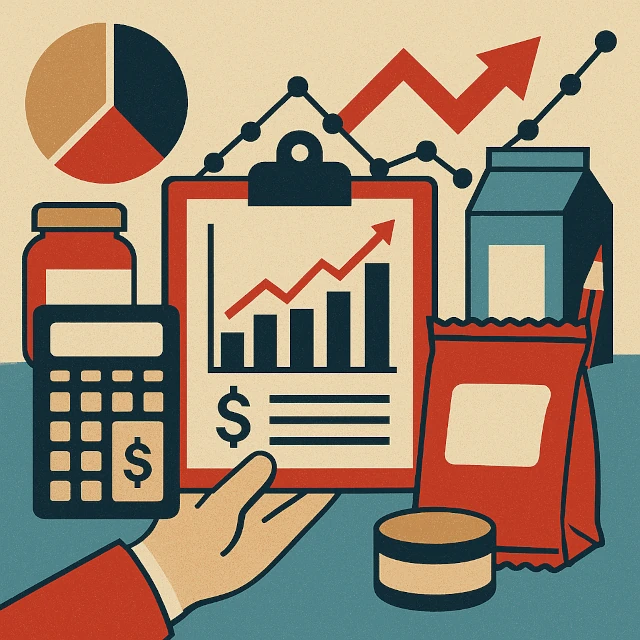Key Financial Metrics Every CPG Founder Must Know

Hi, I’m Kenji. I’ve built, scaled, and advised dozens of CPG brands—from health snacks and organic beverages to refrigerated entrees and specialty condiments. I’ve also served as a fractional and full-time CFO for several of them. One thing I’ve learned over the years? Founders who understand their numbers build better businesses.
This article is a comprehensive guide to the key financial metrics that every CPG founder should know and track. Whether you’re just launching your first SKU or preparing for Series A, mastering these numbers will set you apart from your competition.
Why Financial Metrics Matter in CPG
CPG is one of the toughest industries when it comes to margins, operations, and cash flow. You’re managing physical products, inventory, trade spend, promotions, brokers, distributors, and more. Financial metrics aren’t just accounting jargon—they’re tools to help you make smarter decisions, pitch investors with confidence, and scale sustainably.
1. Gross Margin
What it is: Gross Margin = (Revenue - Cost of Goods Sold) / Revenue
Why it matters: This tells you how much money is left over after making your product, before any other expenses. For most CPG brands, a healthy gross margin is between 35%–50%, depending on your category.
- Always track gross margin per channel and per SKU.
- Be vigilant about co-manufacturer price increases, ingredient shifts, and packaging changes.
- Reformulate if necessary to hit better margins without compromising quality.
2. Contribution Margin
What it is: Contribution Margin = Gross Margin - Variable Costs (like freight, commissions, trade spend)
Why it matters: Contribution margin is your real operating fuel. It shows what’s left to cover fixed costs and eventually generate profit. This is often where new brands get tripped up.
Tips: Map out variable costs per channel, especially distributor and retailer fees. Avoid the temptation to over-promote without tracking effectiveness.
3. EBITDA
What it is: Earnings Before Interest, Taxes, Depreciation, and Amortization.
Why it matters: EBITDA is a standard measure of profitability and often used by investors. It shows how your business performs operationally without being distorted by capital structure or tax quirks.
4. Burn Rate
What it is: The amount of cash you’re spending each month to operate the business.
Why it matters: It’s a lifeline metric for any venture-backed brand. Burn too fast, and you’ll run out of cash before your next raise.
Tips: Build a 12-month cash flow forecast and stress test it. Know your fixed costs cold. Understand how long your runway is—today.
5. Trade Spend %
What it is: The percentage of your gross sales spent on promotions, discounts, demos, distributor fees, and slotting.
Why it matters: Trade spend can eat 10%–30% of your revenue. If you don’t track it, you’ll feel the cash squeeze before you see it in your P&L.
Tips: Track all deductions and chargebacks. Use trade spend to build velocity, not just buy shelf space.
6. Revenue per Point of Distribution (Rev/POD)
What it is: Revenue per store, per SKU, usually calculated monthly.
Why it matters: Helps you understand store-level velocity. Low Rev/POD means poor sell-through. This metric is critical for convincing buyers to expand your footprint.
Tips: Set benchmarks by category. Use velocity data to tell a strong sell story during resets.
7. Inventory Turns
What it is: The number of times inventory is sold and replaced over a period (usually a year).
Why it matters: Low inventory turns mean cash is tied up in stock. High turns = better working capital efficiency.
Tips: Avoid deadstock. Use demand forecasts and lead times to manage turns.
8. Days Sales Outstanding (DSO)
What it is: Average number of days it takes to collect payment from customers.
Why it matters: The longer it takes to get paid, the more cash pressure you’re under. Net 30 can easily stretch to net 60 if you’re not careful.
Tips: Enforce terms. Build strong AR processes. Offer discounts for early payment only when needed.
9. Cost of Customer Acquisition (CAC)
What it is: Total cost to acquire a new customer through paid media, sampling, promotions, and field marketing.
Why it matters: Knowing CAC helps you assess if your marketing spend is sustainable and if you can eventually reach profitability.
Tips: Pair CAC with Customer Lifetime Value (LTV) to evaluate ROI.
10. Customer Lifetime Value (LTV)
What it is: The total revenue you earn from a customer during their relationship with your brand.
Why it matters: Higher LTV means you can afford higher CAC. It also helps justify higher spend on retention, email, loyalty, and DTC infrastructure.
Conclusion
As a CPG founder, you don’t need to be a CPA—but you do need to understand your numbers. These metrics aren’t just for finance nerds; they’re tools to help you run smarter, scale faster, and fundraise more effectively. The brands that survive—and thrive—are the ones who use data as a competitive edge.
Need help setting up dashboards, tracking KPIs, or understanding your cash flow? Drop me a line—I’ve seen every spreadsheet nightmare and survived to tell the tale.


